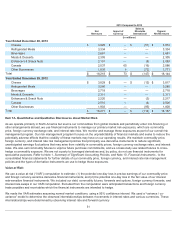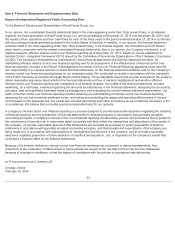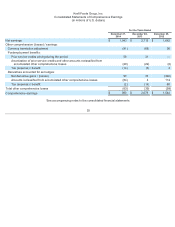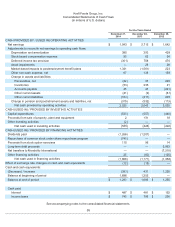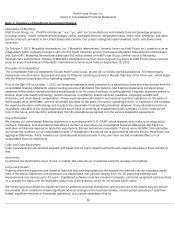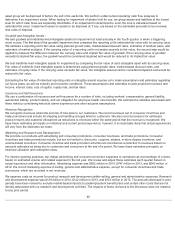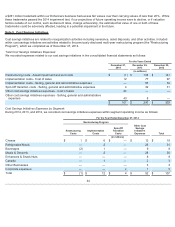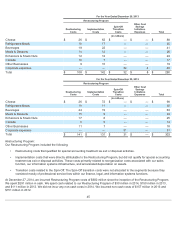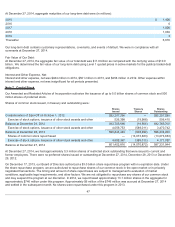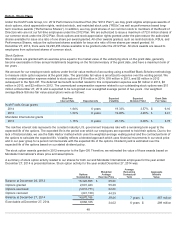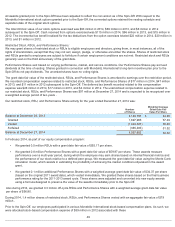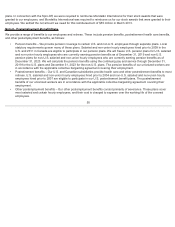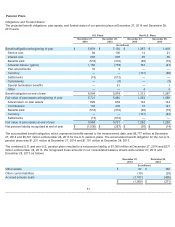Kraft 2014 Annual Report Download - page 46
Download and view the complete annual report
Please find page 46 of the 2014 Kraft annual report below. You can navigate through the pages in the report by either clicking on the pages listed below, or by using the keyword search tool below to find specific information within the annual report.
Environmental Costs:
We are subject to various laws and regulations in the United States and Canada relating to the protection of the environment. We
accrue for environmental remediation obligations on an undiscounted basis when amounts are probable and can be reasonably
estimated. The accruals are adjusted based on new information or as circumstances change. We record recoveries of
environmental remediation costs from third parties as assets when we believe these amounts are receivable. As of December 27,
2014, we were involved in 56 active proceedings in the United States under the Comprehensive Environmental Response,
Compensation and Liability Act (and other similar state actions and legislation) related to our current operations and certain closed,
inactive or divested operations for which we retain liability.
As of December 27, 2014, we had accrued an amount we deemed appropriate for environmental remediation. Based on
information currently available, we believe that the ultimate resolution of existing environmental remediation actions and our
compliance in general with environmental laws and regulations will not have a material effect on our financial condition or results
from operations. However, we cannot quantify with certainty the potential impact of future compliance efforts and environmental
remediation actions.
Postemployment Benefit Plans:
We provide a range of benefits to our eligible employees and retirees. These include defined benefit pension, postretirement health
care, defined contribution, and multiemployer pension and medical benefits. Our pension, postretirement, and other
postemployment (collectively, “postemployment”) benefit plans cover most salaried and certain hourly employees. The cost of these
plans is charged to expense over the working life of the covered employees.
We account for defined benefit costs using a mark-to-market policy. Under this accounting method, we recognize net actuarial
gains or losses and changes in the fair value of plan assets in cost of sales and selling, general and administrative expenses
immediately upon remeasurement, which is at least annually.
Financial Instruments:
As we operate primarily in North America but source our commodities on global markets and periodically enter into financing or
other arrangements abroad, we use a variety of risk management strategies and financial instruments to manage commodity price,
foreign currency exchange rate, and interest rate risks. Our risk management program focuses on the unpredictability of financial
markets and seeks to reduce the potentially adverse effects that the volatility of these markets may have on our operating results.
One way we do this is through actively hedging our risks through the use of derivative instruments. As a matter of policy, we do not
use highly leveraged derivative instruments, nor do we use financial instruments for speculative purposes.
Derivatives are recorded on our consolidated balance sheets at fair value, which fluctuates based on changing market conditions.
Certain derivatives are designated as cash flow hedges and qualify for hedge accounting treatment, while others do not qualify and
are marked to market through earnings. For cash flow hedges, changes in fair value are deferred in accumulated other
comprehensive earnings / (losses) within equity until the underlying hedged items are recognized in net earnings. Accordingly, we
record deferred cash flow hedge gains or losses in cost of sales when the related inventory is sold and in interest and other
expense, net, when the related debt interest expense is recorded. Cash flows from derivative instruments are also classified in the
same manner as the underlying hedged items in the consolidated statement of cash flows. For additional information on derivative
activity within our operating results, see Note 10, Financial Instruments .
To qualify for hedge accounting, a specified level of hedging effectiveness between the hedging instrument and the item being
hedged must be achieved at inception and maintained throughout the hedged period. Any hedging ineffectiveness is recognized in
net earnings when the change in the value of the hedge does not offset the change in the value of the underlying hedged item. We
formally document our risk management objectives, strategies for undertaking the various hedge transactions, the nature of and
relationships between the hedging instruments and hedged items, and method for assessing hedge effectiveness. Additionally, for
qualified hedges of forecasted transactions, we specifically identify the significant characteristics and expected terms of the
forecasted transactions. If it becomes probable that a forecasted transaction will not occur, the hedge will no longer be effective and
all of the derivative gains or losses would be recognized in earnings in the current period.
Unrealized gains and losses on our derivatives not designated as hedging instruments as well as the ineffective portion of
unrealized gains and losses on our derivatives designated as hedging instruments, are recorded in
41


